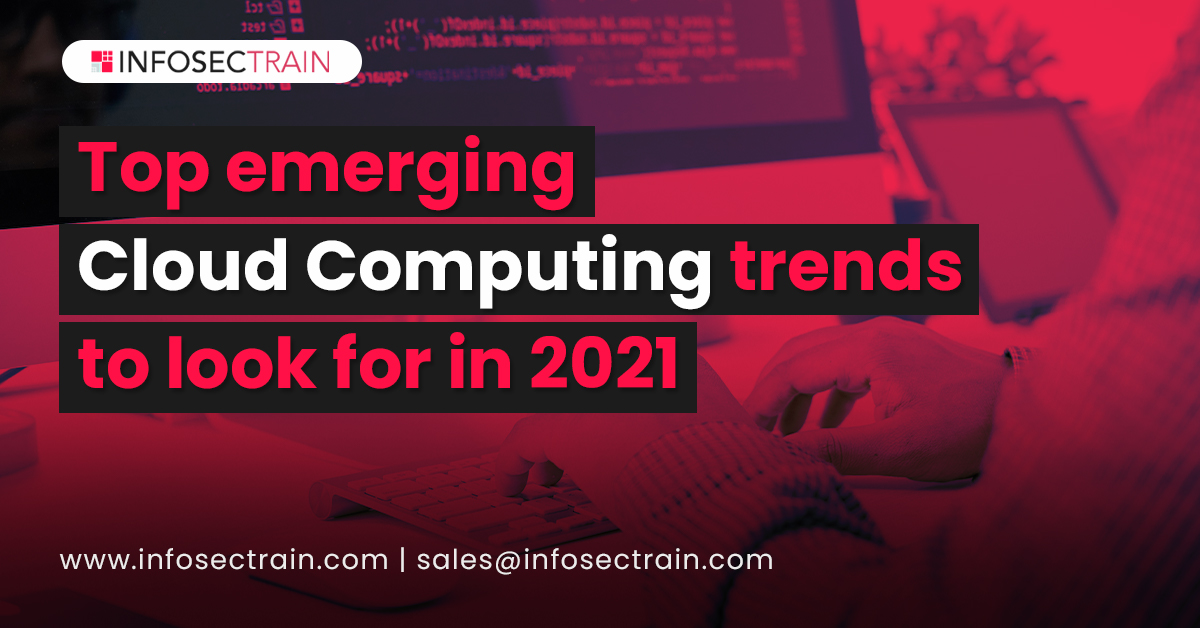Top Emerging Cloud Computing Trends To Look for in 2021
Cloud computing has occupied a significant part of the technology market. The consequences of incidents experienced in 2020 have ensued most forecasts for 2021. Cloud computing sustained the world’s economy, overall supply chains, and remote workforces during the coronavirus pandemic. It will continue to be an essential objective for organizations looking for expanded scalability, business continuity, and cost proficiency in 2021.

Several prime trends of the Cloud will determine the directions in which technology will frame our future in subsequent times. Nevertheless, the most vital use cases now require helping us to accommodate and withstand the uncertain times we are living in. Cloud is the spine of the data-driven applications dependent on the tech ecosystem as it has been indispensable in accomplishing this transition. From job search to home delivery services, accessing remote location systems, and working from home have revolutionized Cloud services. In 2021 we will see the progress in this transformation rate. More major businesses seek to adopt the Cloud models because delivering data from the Cloud to our devices become more essential to our daily lives. Here are the top trends in Cloud Computing that you can watch for in 2021:
Zero Trust Model
Zero Trust is a security notion focused on the possibility that organizations must not trust anything inside or outside its perimeters and should rather verify everything without exception, attempting to connect to its systems before granting access. The Zero Trust model of information security essentially kicks to the curb the old castle-and-moat mentality that had organizations directed on securing their perimeters while considering everything already inside didn’t bear a threat and consequently was cleared for access. According to the experts, many enterprise IT shops are now doing numerous bits of Zero Trust. They usually possess multifactor authentication, IAM, and permissions in place. They’re also progressively executing micro-segmentation in parts of their environment.
Multi-Cloud and Joint Cloud Provider Offerings
Multi-Cloud can be defined as using more than one cloud computing and storage services in a single complex architecture or the distribution of cloud assets, software, applications, etc., over various cloud-hosting environments.
Joint Cloud is a recent age computing model that promotes developers to customize cross-cloud services by software-defined integration and collaboration amidst various cloud service entities.2021 will see the commencements of multi-cloud and joint provider cloud augmentations. Also, the automation skills for container platforms resolve multi-cloud access, so organizations have a compelling way for different cloud suppliers or for different infrastructure or different sorts of the Cloud.
Disaster Recovery Services
The cost of downtime is growing rapidly as an always expanding number of organizations choose digital advancements. For example, an e-commerce organization’s downtime infers bungled opportunities for sales. Of course, organizations are under rules. For instance, GDPR is supposed to deal with client data carefully.
Organizations ought to follow all the authentic terms while designing their disaster recovery approaches. Consequently, organizations are now steadily shifting towards DR-as-a-Service, which would entirely minimize the recovery time.
Hybrid Cloud Computing
A hybrid cloud is an answer consolidating a private cloud with at least one public cloud service, with exclusive software that facilitates correspondence between each different service. A hybrid cloud technique provides more prominent flexibility to businesses as it relocates the workloads between cloud solutions when requirements and expenses alternate.
There are various organizations that use the hybrid cloud computing system in order to maintain their workflow and production, and there are more in the line that is moving to it. Various experts have also accepted the fact that by 2021, different organizations will adopt hybrid cloud computing. Hybrid cloud computing possesses ideal speed, remarkable control, and improved security.
Data Security
Data security refers to defending the digital data from harmful forces and from the undesired actions of unapproved users, such as a cyberattack or a data breach. Security approaches for data in motion are illustrated by software-defined perimeters that organize public key access with encryption only when it opens up a secure UDP port, briefly, to frame an application-level connection.
FaaS Implementation in Cloud
FaaS, defined as Function-as-a-Service, is a crucial part of the cloud-computing service that enables you to run code in answer to events while sustaining a strategic distance from the adoption of complex infrastructures. This allows you to direct completely on singular functions in your application code. It is a division of serverless computing and generally focuses on its service categories like gateways, storage, API, and competitions. It ensures that the developer can build confounded codes faster than it’s IaaS and DaaS partners, as it is simpler assistance. It is assumed that in 2021, more tech goliaths will choose FaaS as a tool for their regular business.
Serverless Computing
Serverless computing is a strategy for proffering backend services on an as-used basis. A serverless supplier permits clients to compose and deploy code without being bothered regarding the underlying infrastructure.
Serverless computing has exponentially grown due to the rising necessity for conventional development to go serverless for progress. It redistributes the complete foundation by isolating the beginning and end apart from the app. The pay as you go system is an example of the serverless models that have a common structure. These projects are flexible and empower organizations to have more authority over their expenses in cloud hosting.
Hyper-scale Data Centers
In today’s computerized era, immediate consumption has prompted organizations to operate at a boisterous speed where their IT frameworks must deliver services faster than any customary framework. Moreover, they require an IT infrastructure that can scale at different speeds to fulfill increased demand. Hence, hyper-scale data centers demand prompting because they can scale dramatically and swiftly to respond to progressively massive demand.
Edge Computing
Edge computing is a shared, open IT structure that highlights decentralized processing power, facilitating mobile computing and Internet of Things (IoT) technologies. Edge computing enables data to be processed by the device itself or by a local PC or server. Thus, data is not transmitted tothe data center for processing.
Multi-cloud’s enterprise utility reflects the growing distribution of the data aspect. The fluctuating degrees of isolation accredited to the prevailing general wellbeing environment is expanding this pattern and edge computing’s reasonability at the Cloud’s fringe. Gradually heterogeneous circumstances fundamentally reinforce the need to connect them, where multi-cloud deployments excel.
Joined services of Big Data, Cloud Computing, and IoT
As Cloud computing associates with Big Data and IoT, it is expected to improve in 2021. The foremost tech goliaths will definitely meet the consolidated services and make it a trend. A couple of organizations are operating on the assistance of Big Data and IoT as they are progressing propels.
Big Data provides data recognized with a specific enterprise after it is processed and interpreted. IoT is the place where physical devices with valid interconnection can be used for production. If Cloud computing unites Big Data and IoT, an organization can increase its production. Organizations can acquire permission to the vital information of their opponents and more effort into making better business decisions for what’s to come.
Automated Cloud Orchestration and Optimization
Cloud platforms will continue creating automated cloud orchestration. Optimization as the varied idea of administering both the quality and quantity of interconnected services across applications overwhelms even the most perceptive IT organizations.
Automated service and performance management should be the fundamental approach for choosing a cloud provider in 2021. Organizations may have to deal with a hundred or more services from a single cloud provider.
These are the Cloud computing trends in 2021 that will establish the course of action for technology to frame our future in the wake of time. This will increase efficiency across your workflows by ensuring that everyone is using the updated synchronized technology. It also enhances security as being aware of the latest trends in Cloud Computing can further bring strength to our Cloud Infrastructure. All the devices should be managed in a centralized way rather than ensuring that everyone in the network follows the best practices.




 1800-843-7890 (India)
1800-843-7890 (India) 
